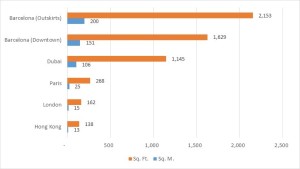Time to invest in Spanish Real Estate for European Residency
In late 2013, the Spanish Parliament released the Entrepreneurs’ Act (Law 14/2013), which, among other measures, includes a historic amendment to the Spanish immigration law. Spain has just introduced a new investor visa regime, which grants a residency permit to non-EU nationals who make a substantial investor within the country. Spain thus follows the Anglo-Saxon tradition of providing residency or citizenship in exchange for investment, as it happens in the UK, US, Canada and Australia. In August 2015, a number of amendments were introduced to the new Spanish Law to make it even more attractive.
The new investor visa in Spain applies to non-EU nationals having invested at least € 500,000 in real estate, € 2 million in government debt or € 1 million in shares of Spanish companies. Unlike other countries, the Spanish visa also applies to the investor’s entire family, i.e. espouse and children of all ages, as long as they depend on the parents. The holder is not required to actually live in Spain and does not become a tax resident.
The visa is valid for the entire Schengen Area of 26 European countries, thereby enabling full mobility of the visa holder across a vast region, ranging from Lisbon to Athens, from Marbella to Stockholm. This represents a clear advantage against other jurisdictions such as Cyprus or the UK, which also offer investor visas but are not members of the Schengen Area.
As the following data show, Spain has recorded one of the worst declines in housing prices across the EU during the global financial crisis. However, in 2014, property prices started to pick up again in Spain, showing that now is the best time to invest in Spanish real estate.
Foreign capital is coming back to a country that offers safety, stability, clean environment, mild climate, as well as affordable and diverse properties, from big cities to ski resorts and coastal villages. For instance, an investment of € 500,000 provides access to relatively sizable properties when compared with other European and Middle Eastern cities, as shown below.
Change in average housing prices (2007-2012)

Source: EU Statistics Office (Eurostat)
Size of apartment that € 500,000 can afford in each city

Source: Knight Frank, Tasinsa.
In addition to real estate, foreigners who acquire or establish a business in Spain are also eligible for a residency permit. In principle, they should invest at least € 1 million in capital, but contributions can be in kind (e.g. stock, technology, fixed assets, etc.) and investments of lower value can also be considered if a business plan is provided.
For investors with lower purchasing power, the rules of the traditional Immigration Law (Law 4/2000) are still valid. They provide residency for foreign families with sufficient regular income and having invested in a property in Spain, regardless of value. However, unlike the new Law 14/2013, the “old law” requires residency holders to live in Spain more than 183 days per year. Therefore, this regime is ideal for families interested in actually residing and schooling their children in Spain. In fact, Spanish permanent residency or citizenship are only available in the case of effective residency.
Finally, the tiny country of Andorra, in the north of Spain, also offers a new residency package since 2012. The program combines well with the Spanish investor visa to obtain Schengen civil residency along with tax residency in a low-tax jurisdiction.
Please Contact Us for more information.
About the Author
Jacinto Soler-Matutes holds a Ph.D. in International Economics with a major on emerging markets. He has been advisor to Spanish companies and institutions on relations with the emerging economies.
Dr. Soler-Matutes is also an Associate Professor at the School of Asian Studies of University Pompeu Fabra (UPF) in Barcelona.
